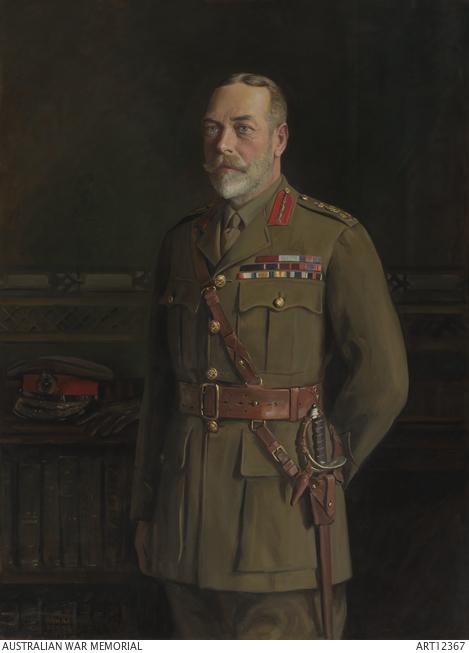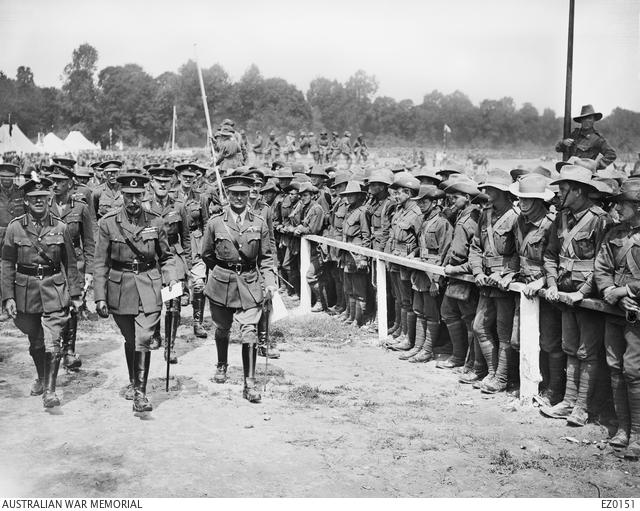A ‘conspicuous omission’ in the National Collection
In an examination of the acquisition of the Australian War Memorial’s 1935 portrait of King George V by John Berrie, Spiros Zournazis Memorial Fellow Laura Cook reveals some of the difficulties of commissioning royal portraiture
King George V (1865–1936) was one of the most compelling imperial symbols of the First World War, the figurehead whom all new recruits across the British Empire swore to ‘well and truly serve’. For many, this loyal cultural identification with the Empire was the dominant public and political imperative that impelled Australia to join the war in Europe in 1914. In 1917, for example, soldier John McRae recorded how proud he was ‘to think that I may in my small way help the King & his ministers in their “Crusade”’.[1] While this rosy view of the King’s leadership was unlikely to have been shared by all Australians, it was a perception that would become firmly embedded in cultural consciousness after the war.
How would George V be portrayed in an official portrait, destined to be displayed in the nation’s memorial to those who died? By 1934, this ‘conspicuous omission’ from the Memorial’s planned galleries prompted the fledging Board to take urgent steps to commission a portrait.[2] A portrait of the man who had ‘wisely guided the Empire through the difficult years of war’ was perceived as an important part of the National Collection.[3] As the Prime Minister, Joseph Lyons, wrote in August 1934 to Stanley Bruce, the Australian High Commissioner in London, this would be ‘keenly appreciated by all Australians and especially by the men and women who served during the war.’[4]
Despite this early optimism, the acquisition would prove to be a lengthy and fraught exercise that ultimately incurred ‘heavy expenditure’.[5] Although they hoped for an original work by an Australian artist, preferably depicting the King in his role as Colonel-in-Chief of the Australian Light Horse, the necessary sittings could not be arranged as the King’s Jubilee celebrations took place the same year.
In the end, Memorial staff settled for commissioning a copy, in the painter’s own hand, of an oil on canvas work by the English artist John Berrie (1887–1962). The original version had been commissioned in 1931 by the 2nd Battalion, The King's (Liverpool) Regiment, and exhibited to great acclaim at the Royal Academy in the same year. By February 1935, Berrie had all but completed his copy when the King issued a further direction (as Bruce noted, ‘tantamount to command’) that he be depicted instead in the uniform of Commander-in-Chief of the British Army, thus necessitating a multitude of last minute changes.[6] The justification was that this was the King’s most familiar persona, ‘seen by the Australians when His Majesty visited them on the battlefields in France, and in military hospitals, and when they attended investitures at Buckingham Palace.’[7]
The final portrait depicts the King in three-quarter profile gazing at the artist. He wears the khaki uniform of a field marshal with medal ribbons dating from the First World War. The statuette of the British lion, shown in the background of the original work, has been replaced by a low side table on which rest the hat and gloves required to complete the King’s outfit.
While this decision about his clothing produced an original work for the National Collection, as had been desired at the outset, it also rendered useless the 5,000 reproductions of the first version, in various sizes, that had been ordered in advance from the English copyright holder, the printmaker Raphael Tuck & Sons of London. Before he could be prevented, the artist also signed over the copyright of the revised portrait to Tuck’s. The costs to the Memorial ran to thousands of pounds.
When the portrait and the correct reproductions arrived in Australia in April 1935, one Memorial staff member commented that ‘this is the first time that anything connected with the portrait has gone right.’[8] Staff had hoped that many private citizens and public groups would be interested in purchasing the King’s portrait, and that the sale, framing and distribution of reproductions would provide work for returned soldiers. However, sales amounted to only a few hundred, perhaps owing to the relatively high cost at a time of national economic depression.
Allan Inglis, a schoolteacher from Walker Flat, South Australia, for example, tartly observed that local parents lacking ‘necessary things, such as boots and shoes for their children, and clothing, and food’ had declined to purchase a portrait. These people, he maintained, were ‘doing more to set Australia on her feet than those who would rush forth to purchase this painting to order to show others their loyalty.’[9]
The market was also challenged by local newspapers that printed souvenir editions containing images of a similar size. Leonard Wilson, a schoolteacher from Yarram, Victoria, observed that while it was ‘not practicable at present’ to purchase a copy of the Jubilee portrait, The Star newspaper’s souvenir had been hung in the school instead.[10]
King George died soon after, in January 1936. Staff members turned their attention instead to the establishment of the Memorial in Canberra, as political tensions increased in Europe.
Although this portrait would never be displayed as planned, the story of its acquisition for the Memorial’s collection gives new insight into some of the difficulties of commissioning royal portraiture, and the way King George’s image was used to encourage and sustain Empire loyalty for the King. In both formal and informal contexts, portraits such as this are an important part of a suite of imperial symbols used to give moral purpose and legitimacy to Australia’s war effort, both at home and on the battlefields.

Berrie’s depiction of King George as Field Marshal of the British Army emphasised his role as the Dominions’ ‘soldier King’.

The King (second from left) conducted hundreds of morale-raising reviews, inspections and investitures, both in Britain and along the Western Front, that made him familiar to the ordinary soldier.
[1] Mitchell Library, State Library of New South Wales, MSS 1031, John Duncan McRae diaries. Entry for 17 April 1917. Punctuation in original.
[2] Australian War Memorial (AWM) record 21/6/14. Minutes of Finance Committee meeting, 18 March 1935.
[3] AWM record 21/6/14. Draft media release [?], undated, likely March 1935.
[4] AWM record 21/6/14. Letter from Joseph Lyons to Stanley Bruce, 8 August 1934.
[5] AWM record 21/6/14. Minutes of Finance Committee meeting, 18 March 1935.
[6] AWM record 21/6/14. Cablegram from Stanley Bruce to Earle Page, 23 February 1935.
[7] AWM record 21/6/14. Minutes of Finance Committee meeting, 18 March 1935.
[8] AWM record 21/6/5. Letter from unidentified AWM employee to R. Rowe, Department of the Interior, 9 April 1935.
[9] AWM record 21/6/14/6. Letter from Allan Inglis to Harry Chauvel, 1 May 1935.
[10] AWM record 21/6/14/6. Letter from Leonard Wilson to John Treloar, 10 May 1935.